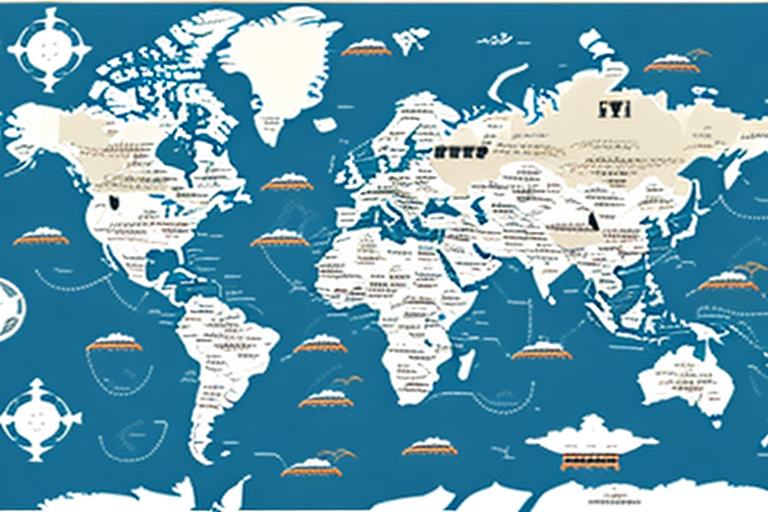Understanding Shopify's International Shipping Rates for UPS
Shopify is a leading ecommerce platform that empowers merchants to create and manage their online stores seamlessly. A standout feature of Shopify is its capability to configure international shipping rates, enabling merchants to reach a global customer base. Among the carriers available for international shipping on Shopify, UPS stands out as a global leader in logistics and transportation services. This article delves into the process of setting up and managing international shipping rates with UPS on Shopify. We will explore the benefits, costs, and best practices for leveraging UPS for international shipping on Shopify.
How to Set Up International Shipping Rates for UPS on Shopify
Configuring international shipping rates on Shopify is a straightforward process. Follow these steps to set up UPS as your international shipping carrier:
- Access Shipping Settings: Navigate to the Shopify admin panel, click on the "Settings" tab, and select "Shipping and delivery."
- Select Shipping Zones: Define the regions or countries you intend to ship to by setting up shipping zones. Group multiple countries or regions to apply uniform shipping rates.
- Create a Shipping Profile: Within your shipping settings, create a new shipping profile and choose UPS as your carrier.
- Choose UPS Shipping Options: Select from a variety of UPS services, including standard, expedited, and express. Tailor different rates based on shipping zones or weight tiers to meet your business needs.
- Test Your Setup: Place a test order to ensure that shipping rates are accurately calculated and applied during checkout.
When setting up international shipping rates, consider additional fees such as customs duties and import taxes that may apply in the destination country. Research these fees and incorporate them into your shipping rates to prevent unexpected costs for your customers. Clearly communicate any potential fees or taxes on your website to maintain transparency and trust.
The Benefits of Using UPS for International Shipping on Shopify
Choosing UPS as your international shipping carrier on Shopify offers numerous advantages:
- Reliable Delivery: UPS is renowned for its fast and dependable delivery services worldwide.
- Comprehensive Tracking: Advanced tracking and visibility options keep both merchants and customers informed about shipment statuses.
- Seamless Integration: UPS integrates smoothly with Shopify's shipping settings and fulfillment services, streamlining your logistics operations.
- Competitive Rates: Shopify's shipping discounts provide access to competitive UPS rates, enhancing your profitability.
Additionally, UPS's expertise in customs clearance is invaluable. Their team of customs brokers adeptly navigates the complex customs regulations of various countries, ensuring swift and efficient clearance of your shipments. UPS also offers value-added services such as insurance, specialized packaging, labeling, customs compliance consulting, and trade management tools, enriching your international shipping experience.
Factors Affecting International Shipping Rates on Shopify
Several factors influence international shipping rates on Shopify, including:
- Destination: The country or region to which you are shipping significantly impacts the shipping rate.
- Carrier and Service Level: The chosen shipping carrier and the level of service (e.g., standard vs. express) affect costs.
- Package Weight and Dimensions: Heavier and larger packages incur higher shipping rates.
- Product Value: The declared value of the products can influence insurance costs and import taxes.
- Customs and Import Regulations: Varying regulations and fees in destination countries can affect overall shipping costs.
Delivery time frames also play a crucial role; expedited shipping services typically cost more than standard or economy options. The nature of the product, such as hazardous materials or oversized items, may require special handling, leading to additional fees.
Calculating International Shipping Rates for UPS on Shopify
Accurately calculating international shipping rates for UPS on Shopify involves several considerations:
- Package Specifications: Determine the weight and dimensions of each package to ensure precise rate calculations.
- Destination Details: Identify the destination country and region, as shipping rates vary geographically.
- Service Selection: Choose the appropriate UPS service level (standard, expedited, express) based on customer needs and budget.
Utilize Shopify's built-in shipping calculator to estimate rates for UPS and other carriers based on these parameters. Additionally, be mindful of destination countries' customs regulations and taxes, which can influence both shipping costs and delivery times. Researching these factors beforehand can help in setting accurate shipping rates.
Packaging materials also impact shipping rates. Opt for lightweight, durable packaging to minimize package weight and dimensions, thereby reducing shipping costs. Ensuring proper packaging not only protects your products but also helps avoid dimensional weight fees imposed by carriers like UPS.
Tips for Reducing International Shipping Costs on Shopify with UPS
International shipping can be costly, but implementing the following strategies can help mitigate expenses when using UPS on Shopify:
- Leverage Shipping Discounts: Take advantage of Shopify's shipping discounts to access lower UPS rates.
- Optimize Shipping Services: Consider using slower shipping options or consolidating multiple orders to decrease shipping frequency and costs.
- Optimize Packaging: Reduce package weight and dimensions to avoid dimensional weight fees and lower shipping costs.
- Pre-Calculate Taxes and Fees: Incorporate taxes and customs fees into your shipping rates to prevent unexpected charges for customers.
Negotiating rates directly with UPS can also lead to significant savings, especially for businesses with high shipping volumes. Contact your UPS representative to discuss your shipping needs and explore eligibility for discounted rates.
Additionally, partnering with a third-party logistics provider (3PL) can streamline your international shipping operations. 3PLs often secure better rates with carriers like UPS and manage all aspects of international shipping, including customs clearance and documentation, allowing you to focus on core business activities.
Common Mistakes to Avoid When Setting Up International Shipping Rates on Shopify with UPS
Setting up international shipping rates on Shopify requires careful attention to detail to avoid common pitfalls:
- Incorrect Package Specifications: Ensure accurate weight and dimensions to prevent incorrect shipping rates and additional fees.
- Overlooking Customs Regulations: Failing to research destination countries' customs and import regulations can lead to shipment delays or additional charges.
- Incorrect Shipping Zones or Rates: Applying the wrong shipping zone or rate can result in customers being overcharged or undercharged.
- Neglecting Taxes and Fees: Not accounting for taxes and customs fees can surprise customers with unexpected charges, harming customer satisfaction.
Another common mistake is not offering multiple shipping options. Customers have varying preferences regarding shipping speed and cost, so providing a range of options enhances the shopping experience. Additionally, failing to provide tracking information can lead to customer frustration. Including tracking details helps keep customers informed and reduces inquiries about shipment statuses.
Best Practices for Managing International Shipments with UPS on Shopify
Adhering to best practices ensures efficient and reliable international shipping with UPS on Shopify:
- Detail-Oriented Product Listings: Provide accurate and comprehensive product descriptions and values to facilitate smooth customs processing.
- Proactive Communication: Monitor shipment tracking and keep customers informed about their order status and any potential delays.
- Clear Shipping Information: Display transparent shipping and delivery information on your Shopify store and in order confirmations.
- Partner with Reliable Fulfillment Services: Collaborate with experienced fulfillment partners or 3PL providers that can manage complex international shipping requirements effectively.
How to Track and Manage Shipments with UPS on Shopify
Monitoring and managing your UPS shipments on Shopify is user-friendly through the Shopify admin panel:
- Shipment Tracking: Access real-time tracking information for each order shipped via UPS directly from your Shopify dashboard.
- Order Notifications: Set up automated notifications to keep customers updated on their shipment statuses and delivery estimates.
Providing customers with tracking links in order confirmations and shipping notifications enhances transparency and trust, contributing to a positive customer experience.
Comparing Shopify's UPS International Shipping Rates with Other Carriers
While UPS is a reliable option for international shipping on Shopify, it's beneficial to compare its rates and services with other carriers to ensure the best fit for your business needs. Shopify offers discounted rates with carriers like DHL and USPS, each with its own set of advantages:
- DHL: Known for its global reach and speed, DHL is an excellent choice for businesses targeting international markets with tight delivery timelines.
- USPS: Offering competitive rates for certain destinations, USPS can be a cost-effective alternative for lightweight and standard shipments.
Evaluate factors such as delivery speed, reliability, tracking capabilities, and cost-effectiveness when comparing carriers to make informed shipping decisions that align with your business goals.
Understanding Customs Fees and Taxes for International Shipments on Shopify with UPS
Customs fees and taxes are integral aspects of international shipping that can impact both shipping costs and delivery times:
- Customs Fees: Charged by the destination country's customs office for processing and handling shipments, these fees vary based on the product type and value.
- Import Taxes: Applied to goods based on their declared value and the destination country's tax policies, import taxes can affect the overall cost of the shipment.
To mitigate unexpected charges and delays:
- Research Regulations: Understand the customs and tax regulations of each destination country to ensure compliance.
- Accurate Documentation: Provide detailed and accurate product information in your shipment documentation to facilitate smooth customs clearance.
Incorporating these considerations into your shipping strategy enhances transparency and customer satisfaction.
Tips for Providing Excellent Customer Service During the International Shipping Process on Shopify
Exceptional customer service during the international shipping process fosters trust and encourages repeat business. Implement the following strategies to enhance the customer experience:
- Transparent Shipping Information: Clearly display shipping rates, estimated delivery times, and any potential additional fees on your Shopify store.
- Proactive Communication: Keep customers informed about their shipment status and promptly address any unexpected delays or issues.
- Provide Tracking Details: Include tracking numbers and links in order confirmations and shipping notifications to allow customers to monitor their shipments.
- Offer Support: Ensure robust customer support to assist with inquiries related to lost or delayed shipments and customs issues.
By prioritizing clear communication and support, you can significantly enhance the overall customer experience and build long-term customer loyalty.
Future Trends and Developments in International Shipping Rates and Carriers on Shopify
The international shipping landscape is continually evolving with advancements in technology, carrier services, and regulatory changes. Key trends to watch include:
- Enhanced Automation: Automation tools for shipping processes are becoming more sophisticated, allowing for greater efficiency and accuracy in order fulfillment.
- Eco-Friendly Shipping Options: With increasing emphasis on sustainability, carriers are offering more environmentally friendly shipping solutions.
- Improved Tracking Technologies: Advances in tracking technology provide more granular visibility into shipment statuses, enhancing transparency for both merchants and customers.
- Regulatory Adaptations: Changes in international trade policies and customs regulations will continue to shape shipping strategies and cost structures.
Staying informed about these trends will enable merchants to adapt their international shipping strategies proactively, ensuring continued efficiency and competitiveness in the global market.
In conclusion, mastering international shipping rates for UPS on Shopify is pivotal for the success of your online store. By implementing best practices, staying abreast of industry developments, and prioritizing customer service, you can effectively leverage Shopify's capabilities to expand your business globally.








